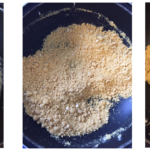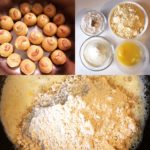Besan Laddoos Deconstructed: The Science Behind This Indian Sweet
By: Sonia Dovedy
Growing up in an Indian household, I was often handed a precious, round morsel to savor during any holiday, religious festival, or simply as a doting gift from a relative. Known as “laddoo,” which translates to “round ball,” these beloved confections of clarified butter, various flours, sugar, dried fruit, and nuts have always held a sweet place in my heart. For my food science class (MET ML 619), I took on the exciting task of exploring the science behind preparing the laddoo.
Some History
Historically, laddoos were created for their medicinal purposes. Comprised of healthful ingredients such as desi ghee, dates, chickpea flour, nuts and seeds, these sweets were meant to invigorate the weak and nourish individuals. Additionally, they served as a perfect ration for warriors and travelers because of their ease in transportation and long storage life. Then, when the British brought sugar to India, the entire purpose of laddoos dramatically changed. Recipes were re-created with the addition of the addicting sucrose, and laddoos became ubiquitous treats, necessary for every celebratory occasion. Today, laddoos come in all varieties – from traditional besan (chickpea flour) laddoos, to coconut laddoos, date laddoos, and more. Yet their shape remains the same – a small, round ball, in adherence to their namesake.

The Project
Within Indian households, cooking is not a science; recipes come from stories, directions come from instinct, and the perfect flavor comes from experience. Thus, when asking the culinary experts of my mother and grandmother for help on decoding the “science” behind one of my favorite sweets, besan laddoo, I did not receive much clear guidance. For example, when asking how long to cook the besan, my mother replied, “I don’t know? Just cook it until it smells roasted. You will know.” After many attempts and questions, I was able to patch together the following recipe:

The Science: I will now explain the science within each step of the recipe as well as the role that the different ingredients play during the process of making besan laddoo.
The Roasting
The first step is to roast the besan, or finely ground chickpea flour in the ghee. Ghee is essentially butter which has been cooked for a long time, until the milk solids have browned and caramelized. These milk solids of casein, lactose, and whey, are then strained from the mixture, and the resulting product is a clear liquid of pure milk fat with nutty, burnt caramel notes. The use of ghee in the laddoo is important for the following reasons:
- It adds nutty, burnt caramel flavors.
- Its high smoke point of 450F is well suited to fry the other ingredients.
- It helps to preserve laddoos for a long period of time. Laddoos store well for up to two weeks!
When the besan undergoes the Maillard reaction, it takes on golden hues, emits a nutty aroma, and transforms into a rich, savory ingredient, essential for this sweet. During the roasting process, it is imperative to roast the besan on a medium-low flame while stirring continuously. This slow, careful process ensures that each granule of besan is exposed to even heat, providing for an even roasting of the flour; this also prevents the besan from burning and becoming bitter.
The next step is to add the non-fat dry milk powder to the besan/ghee mixture, and roast for five more minutes. The use of non-fat dry milk powder in this recipe adds important depth in flavor; here, the concentrated dose of milk sugar, lactose, facilitates the Maillard reaction even further and imparts a sweet, burnt caramel flavor to the laddoo. It is important to note that the milk powder is added to the mixture towards the very end of the roasting process for a short period of time. Otherwise, the milk solids would burn.
The Flavoring
Once roasting is complete, the mixture is removed the heat and allowed to cool minimally – just enough so that it is able to be handled while adding the rest of the ingredients: confectioner’s sugar, cardamom, and a pinch of salt. It is important for the batter to stay warm because sugar and salt are much more soluble in warmer substances than cooler ones, and heat allows for the cardamom spice to release its fragrant oils. There is no concern about over-mixing the batter, because there is no gluten in this recipe.
Regarding sugar, in this recipe, the use of confectioner’s sugar is essential, not only to sweeten this dish, but also to achieve the melt-in-your mouth, creamy consistency that this particular laddoo boasts. Confectioner’s sugar, or granulated sugar that has been ground to a fine powder, contains the same chemical structure as ordinary granulated sugar, sucrose. However, it has a small addition of starch, which helps it to absorb moisture and prevents it from caking. Thus, in this recipe, the confectioner’s variety of sugar is crucial for texture. In addition, cardamom, a familiar spice used in Indian cuisine, provides warming flavor notes to the besan laddoo. When crushed and heated, this seed emits floral, fruity terpene compounds and cineole, an essential oil similar to eucalyptus. Finally, salt (my own personal addition to the recipe), or sodium chloride, intensifies the sweetness and adds a depth in flavor to this dish.
The Formation
The last step of the recipe is to take about two tablespoons of the batter and squeeze it together in your palm a few times in order to form a small round ball. At first, the mixture crumbles, but with firm repetitive motions, it begins to glue together. Here, it is helpful to lightly grease your palms with ghee, as this provides a seal around the laddoo, preventing sticky moisture from entering.

As the laddoos cool, they transform from a soft, crumbly consistency into a firm, solid mass. This change in structure is due to the redistribution of the chemical compounds from the ingredients. For example, as the ghee in the batter cools, it returns to its solid state. In addition, the amylose and amylopectin in the chickpea flour realign in different places around the ghee, producing a thicker, more solid formation. These laddoos can be stored in an airtight container for up to three weeks, making them a suitable travel snack.
The final product of this exploration is a collection of precious confections: dense golden balls, with a crumbly centers that melt into a soft, creamy texture on the tongue. Flavor notes include nutty, roasted, and burnt caramel profiles from the roasting, as well as warm eucalyptus notes from the cardamom. While it is not necessary to know the science behind these round treasures in order to enjoy their sweetness, I would argue that this research adds even more depth to their flavor. Enjoy!
Read more from Sonia at www.bakewithsonia.com and www.cookwithsonia.wordpress.com.

